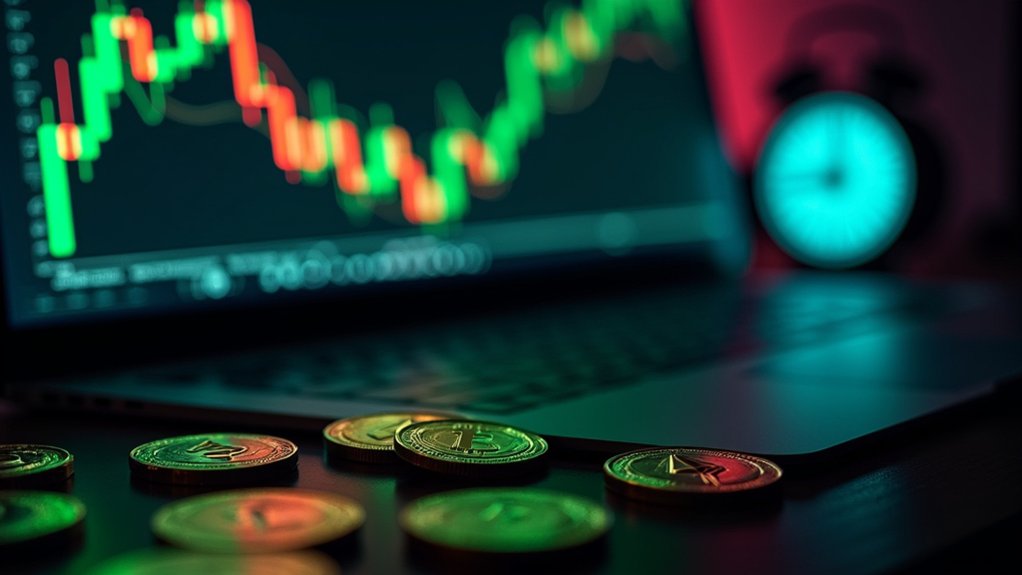Crypto futures contracts, binding deals to buy or sell at a set price on a future date, aren’t child’s play; they’re a brutal arena where volatility can annihilate the unprepared. Traded on platforms like Kraken, they lure with leverage, amplifying every market tremor into ruin, while risks—liquidation, margin calls, manipulation—stalk every move. Think hedging saves you? Hah, it often drags traders deeper into chaos. Stick around; there’s more to unravel.

The volatile world of cryptocurrency, often hailed as a revolutionary frontier, hides a cutthroat mechanism in futures contracts—agreements to buy or sell at a set price on a looming date. Beneath the glossy promises of digital wealth, these instruments, traded on platforms like Kraken, are a double-edged sword, luring speculators with dreams of profit while exposing them to savage Volatility Risks. Dare to speculate without holding the asset? Fine, but don’t cry when the market’s wild swings shred your position overnight, leaving nothing but regret.
Let’s not pretend this is a safe playground; crypto futures, whether fixed-date or perpetual, are not for the faint-hearted, demanding margins and funding rates that can choke the unprepared. Investors might tout these as Hedging Tools, a supposed shield against spot market chaos, locking in prices to dodge potential losses. Sounds clever, doesn’t it? Yet, how often does this ‘protection’ crumble when leverage amplifies every tremor into a financial earthquake, triggering margin calls faster than you can blink? The bitter irony is thick—hedging, meant to save, often lures traders deeper into the abyss. Major exchanges like CME offer Bitcoin and Ether futures, providing regulated trading platforms for these high-stakes contracts. Leverage, a common feature in crypto futures, allows traders to control massive positions with just a small deposit, but it also heightens the risk of complete liquidation.
And while exchanges offer liquidity and a regulated facade, don’t be fooled; high volatility, market manipulation, and regulatory whims can turn your strategy—be it long, short, or scalping—into a cruel jest. Think you’ve mastered speculation or risk management with these contracts, whether cash-settled or physically delivered? Think again. The crypto futures arena, with its standardized terms and expiration dates, isn’t just a game of numbers; it’s a gauntlet, daring you to survive. Perpetual swaps, a popular variant in crypto markets, further complicate the landscape with their unique funding rate mechanism to keep prices aligned with the underlying asset. So, step up if you must, but don’t whine when the market bites—hard. Accountability isn’t optional here; it’s the only currency that matters in this ruthless digital gamble.
Frequently Asked Questions
What Are the Tax Implications of Trading Crypto Futures?
Trading crypto futures carries significant tax implications, including the risk of penalties for Tax Evasion if gains are unreported. Offshore Reporting requirements must be followed to guarantee compliance with international tax laws and regulations.
How Do Leverage Levels Affect Crypto Futures Trading?
Leverage levels greatly impact crypto futures trading by offering Leverage Benefits, allowing traders to amplify gains with smaller capital. However, higher leverage demands strict Risk Management to mitigate substantial losses from market volatility.
Can Beginners Trade Crypto Futures Successfully?
Beginners can trade crypto futures successfully by adopting effective Beginner Strategies. Prioritizing Risk Management is essential to navigate market volatility. With dedication and learning, they can mitigate losses and achieve potential gains.
What Platforms Offer Crypto Futures Trading?
Several platforms offer crypto futures trading, including OKX, WhiteBIT, BTCC, Bybit, and Kraken. They prioritize platform security to protect users and feature intuitive interface design, ensuring accessibility for traders of varying experience levels.
How Does Market Volatility Impact Futures Contracts?
Market volatility greatly impacts futures contracts by altering pricing and trading dynamics. Volatility Patterns often dictate price fluctuations, while Risk Assessment becomes essential for traders to manage potential losses in unpredictable market conditions.










